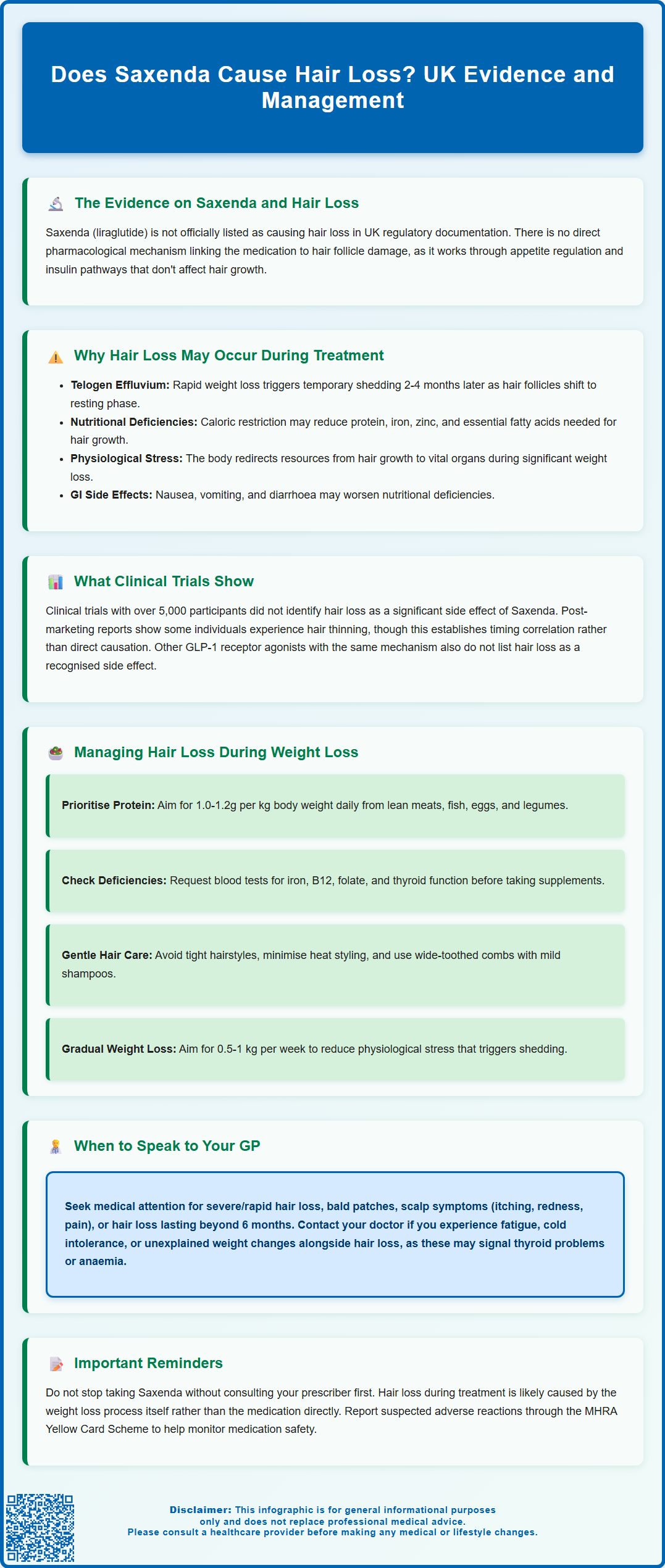Mounjaro®
Dual-agonist support that helps curb appetite, hunger, and cravings to drive substantial, sustained weight loss.
- ~22.5% average body weight loss
- Significant weight reduction
- Improves blood sugar levels
- Clinically proven weight loss

Does Saxenda cause hair loss? This is a common concern among patients prescribed liraglutide 3.0 mg for weight management. Whilst hair loss is not listed as an adverse effect in Saxenda's UK Summary of Product Characteristics, some patients report hair thinning during treatment. The likely explanation relates not to the medication itself, but to the rapid weight loss it facilitates. Significant caloric restriction and weight reduction can trigger telogen effluvium—a temporary form of hair shedding. Understanding the distinction between direct drug effects and weight loss-related changes is essential for appropriate management and patient reassurance.
Summary: Saxenda (liraglutide) does not directly cause hair loss, but the rapid weight reduction it facilitates can trigger temporary hair shedding called telogen effluvium.
Saxenda (liraglutide 3.0 mg) is a glucagon-like peptide-1 (GLP-1) receptor agonist licensed in the UK for weight management in adults with obesity or overweight with weight-related comorbidities. According to the official Summary of Product Characteristics (SmPC) approved by the Medicines and Healthcare products Regulatory Agency (MHRA), hair loss is not listed as an adverse effect of Saxenda at any frequency. However, some patients report experiencing hair thinning or increased shedding during treatment.
It is important to understand that there is no established direct pharmacological mechanism by which liraglutide itself causes hair loss. The drug works by mimicking the incretin hormone GLP-1, which enhances insulin secretion, suppresses glucagon release, slows gastric emptying, and reduces appetite through central nervous system pathways. None of these actions directly affect hair follicle biology or the hair growth cycle.
However, patients using Saxenda typically experience significant caloric restriction and rapid weight loss—both of which are recognised triggers for a type of temporary hair shedding called telogen effluvium. This condition occurs when a large number of hair follicles simultaneously enter the resting (telogen) phase of the hair cycle, leading to noticeable thinning several months later. Therefore, whilst Saxenda itself may not cause hair loss, the weight loss process it facilitates can indirectly contribute to this phenomenon.
Understanding the distinction between drug-related side effects and weight loss-related changes is crucial for appropriate management and patient reassurance. If you experience hair changes whilst taking Saxenda, discuss this with your healthcare provider to identify the underlying cause and explore suitable interventions. Any suspected adverse reactions to medications should be reported through the MHRA Yellow Card Scheme (yellowcard.mhra.gov.uk).

Telogen effluvium is the most common form of hair loss associated with weight management programmes, including those involving Saxenda. This condition is characterised by diffuse hair shedding that typically begins two to four months after a triggering event—in this case, rapid weight loss or significant caloric restriction. The hair follicles prematurely shift from the active growth phase (anagen) to the resting phase (telogen), resulting in increased daily hair shedding that patients may notice when washing or brushing their hair.
Several nutritional factors can contribute to hair loss during weight reduction:
Protein deficiency: Hair follicles require adequate protein for keratin synthesis. Insufficient protein intake during caloric restriction can impair hair growth.
Iron deficiency: Rapid weight loss may deplete iron stores, particularly in menstruating women, leading to anaemia and associated hair thinning.
Zinc insufficiency: This micronutrient plays essential roles in hair follicle health and cellular metabolism.
Essential fatty acid intake: Omega-3 and omega-6 fatty acids support scalp health and hair structure, though deficiency is uncommon with a balanced diet.
Additionally, the physiological stress of significant weight loss itself can trigger telogen effluvium, independent of nutritional status. The body may perceive rapid weight reduction as a stressor, prompting a temporary reallocation of resources away from non-essential functions like hair growth towards vital organ systems.
Gastrointestinal side effects of Saxenda—including nausea, vomiting, and diarrhoea—may further compromise nutritional intake, potentially exacerbating deficiencies. Patients experiencing persistent gastrointestinal symptoms should discuss these with their prescriber, as dose adjustments or additional nutritional support may be warranted to minimise secondary complications including hair changes. A referral to a registered dietitian may be beneficial for personalised nutritional advice during treatment.
The pivotal clinical trials evaluating Saxenda's efficacy and safety did not identify hair loss as a significant adverse event. The SCALE (Satiety and Clinical Adiposity – Liraglutide Evidence) programme, which included over 5,000 participants across multiple international studies, reported the most common side effects as gastrointestinal in nature—nausea, diarrhoea, constipation, and vomiting. Hair loss was not listed among the adverse events occurring in ≥2% of participants in any treatment group, as documented in the published trial results and European Medicines Agency assessment reports.
However, post-marketing surveillance and patient-reported experiences suggest that some individuals do experience hair thinning during Saxenda treatment. The MHRA's Yellow Card scheme, which collects reports of suspected adverse drug reactions in the UK, has received isolated reports of alopecia associated with liraglutide products. It's important to note that these spontaneous reports establish a temporal association but not necessarily causation. They may reflect the well-recognised phenomenon of telogen effluvium secondary to weight loss rather than a direct drug effect.
Review of safety data for other GLP-1 receptor agonists has similarly not identified hair loss as a recognised class effect. Medications such as semaglutide (Wegovy, Ozempic) and dulaglutide (Trulicity) share the same mechanism of action as Saxenda, yet hair loss is not prominently featured in their UK SmPCs either. This further supports the hypothesis that observed hair changes are more likely related to the weight loss process itself rather than a direct pharmacological effect of GLP-1 receptor agonism.
Current evidence suggests that if hair thinning occurs during Saxenda treatment, it is most likely attributable to rapid weight reduction, nutritional factors, or physiological stress rather than a direct toxic effect of liraglutide on hair follicles. Nonetheless, all patients experiencing unexpected symptoms should report these to their healthcare provider for proper evaluation and documentation, and consider reporting through the MHRA Yellow Card Scheme.
If you experience hair thinning whilst taking Saxenda, several evidence-based strategies can help support hair health and potentially minimise shedding:
Nutritional optimisation is paramount. Ensure your weight loss diet includes:
Adequate protein: Aim for approximately 1.0–1.2 g per kilogram of body weight daily, incorporating lean meats, fish, eggs, legumes, and dairy products. Patients with chronic kidney disease should discuss protein targets with their healthcare provider.
Iron-rich foods: Include red meat, dark leafy greens, fortified cereals, and pulses. Consider having vitamin C-rich foods alongside plant-based iron sources to enhance absorption.
Zinc sources: Shellfish, meat, seeds, nuts, and whole grains provide this essential mineral.
B vitamins: Found in eggs, dairy, meat, and fortified products. While biotin (B7) deficiency is rare, it can affect hair health when present.
Omega-3 fatty acids: Oily fish (salmon, mackerel, sardines), walnuts, and flaxseeds support scalp health.
Your GP or prescriber may recommend blood tests to assess for nutritional deficiencies, particularly:
Full blood count (to identify anaemia)
Serum ferritin (iron stores)
Vitamin B12 and folate levels
Thyroid function tests (as thyroid dysfunction can cause hair loss and should be excluded)
Supplementation should be guided by identified deficiencies rather than empirical use. Over-supplementation, particularly of vitamin A, can paradoxically worsen hair loss. If deficiencies are confirmed, targeted supplementation under medical supervision is appropriate.
Gentle hair care practices can minimise mechanical damage:
Avoid tight hairstyles that create tension on hair follicles
Use a wide-toothed comb and minimise heat styling
Choose mild, sulphate-free shampoos
Be patient—telogen effluvium is typically self-limiting, with regrowth occurring once the triggering factor resolves
Gradual weight loss (0.5–1 kg per week) may reduce the physiological stress that triggers hair shedding, though this should be balanced against the clinical benefits of more substantial weight reduction in obesity management. A registered dietitian can provide personalised advice on maintaining nutritional adequacy during weight loss.
Whilst mild hair thinning during weight loss is often temporary and self-resolving, certain circumstances warrant medical review to exclude other underlying causes or complications.
Contact your GP or prescribing clinician if you experience:
Severe or rapidly progressive hair loss: Losing large clumps of hair or developing noticeable bald patches may indicate a condition beyond simple telogen effluvium, such as alopecia areata (an autoimmune condition) or other dermatological disorders.
Hair loss accompanied by scalp symptoms: Itching, scaling, redness, pain, or pustules on the scalp suggest possible infection, inflammatory conditions, or scarring alopecia requiring dermatological assessment.
Patchy or asymmetric hair loss: Telogen effluvium typically causes diffuse thinning across the entire scalp. Localised patches may indicate alternative diagnoses.
Hair loss persisting beyond six months: Telogen effluvium usually resolves within six to twelve months once the trigger is addressed. Prolonged shedding warrants investigation for chronic telogen effluvium or other causes.
Associated symptoms: Fatigue, cold intolerance, unexplained weight changes, or other systemic symptoms may suggest thyroid dysfunction, anaemia, or other metabolic disorders.
Seek urgent medical advice if you experience severe or persistent vomiting, inability to keep fluids down, or signs of dehydration while taking Saxenda.
Your GP may arrange investigations including:
Blood tests for nutritional deficiencies, thyroid function, and inflammatory markers
Scalp examination to assess for dermatological conditions
Referral to dermatology if the diagnosis is uncertain or if specialist treatment is required
Do not discontinue Saxenda without medical advice. If hair loss is significantly distressing, discuss this with your prescriber. They can review your overall treatment plan, assess nutritional adequacy, and determine whether continuing Saxenda remains appropriate for your individual circumstances. In most cases, with nutritional optimisation and time, hair regrowth occurs naturally even whilst continuing weight management treatment. Your healthcare team can provide personalised guidance balancing the substantial metabolic benefits of weight loss against temporary cosmetic concerns.
If you suspect your hair loss may be related to Saxenda, consider reporting this through the MHRA Yellow Card Scheme (yellowcard.mhra.gov.uk), which helps monitor medication safety.
No, hair loss is not listed as an adverse effect in Saxenda's UK Summary of Product Characteristics. However, the rapid weight loss facilitated by Saxenda can trigger temporary hair shedding called telogen effluvium.
Telogen effluvium typically begins two to four months after rapid weight loss and resolves within six to twelve months once nutritional status is optimised and weight stabilises. Hair regrowth usually occurs naturally even whilst continuing treatment.
Ensure adequate protein intake (1.0–1.2 g per kg body weight daily), consume iron-rich foods, maintain sufficient zinc and B vitamins, and consider blood tests to identify any nutritional deficiencies. Gentle hair care practices and gradual weight loss may also help minimise shedding.
The health-related content published on this site is based on credible scientific sources and is periodically reviewed to ensure accuracy and relevance. Although we aim to reflect the most current medical knowledge, the material is meant for general education and awareness only.
The information on this site is not a substitute for professional medical advice. For any health concerns, please speak with a qualified medical professional. By using this information, you acknowledge responsibility for any decisions made and understand we are not liable for any consequences that may result.
Lorem ipsum dolor sit amet, consectetur adipiscing elit, sed do eiusmod tempor incididunt ut labore et dolore magna aliqua. Ut enim ad minim veniam, quis nostrud exercitation ullamco laboris nisi ut aliquip ex ea commodo consequat. Duis aute irure dolor in reprehenderit in voluptate velit esse cillum dolore eu fugiat nulla pariatur.
Block quote
Ordered list
Unordered list
Bold text
Emphasis
Superscript
Subscript